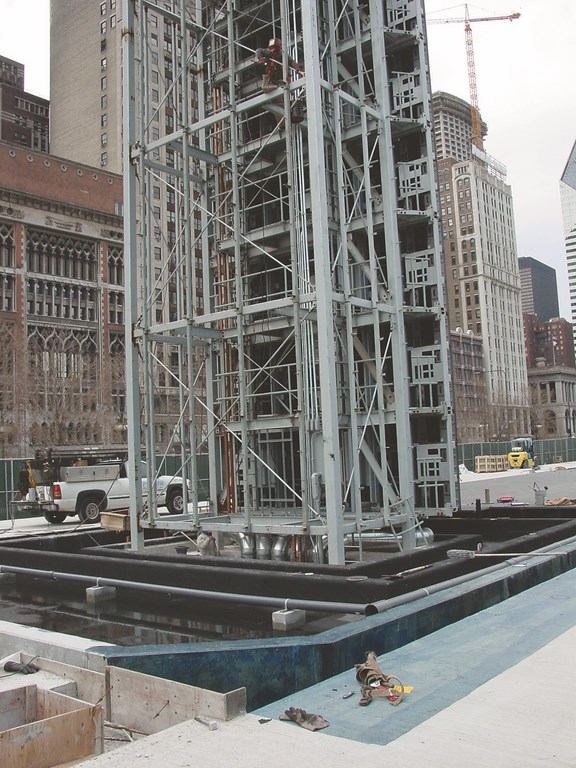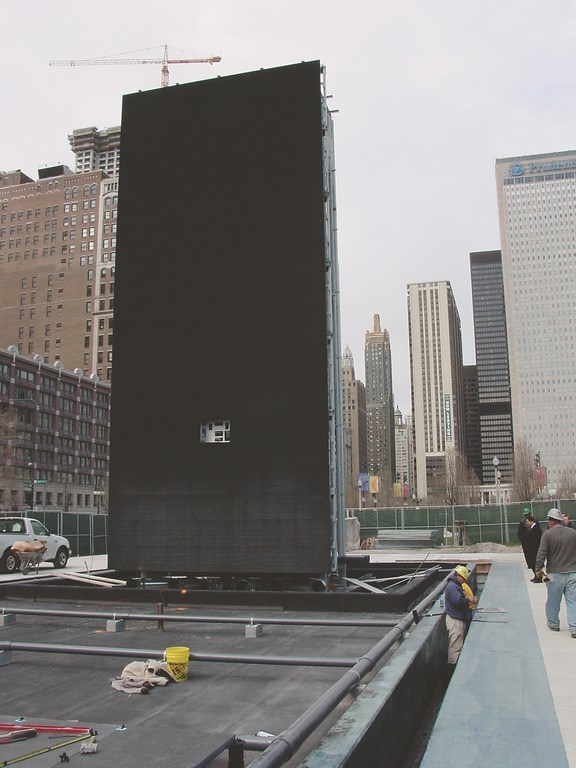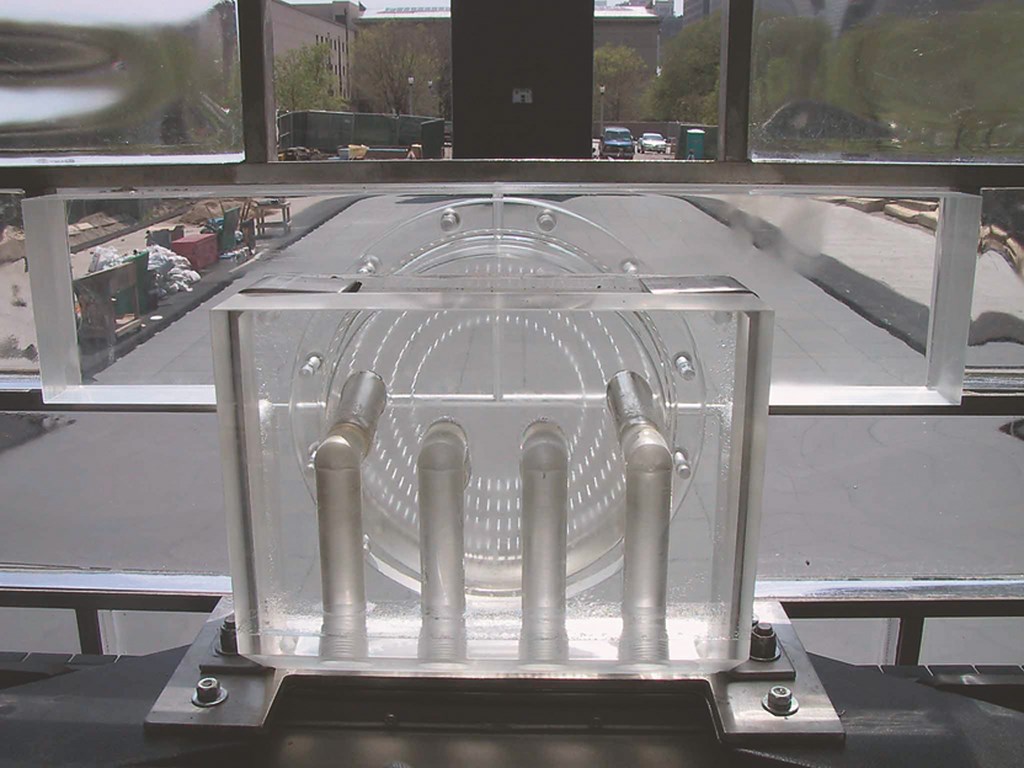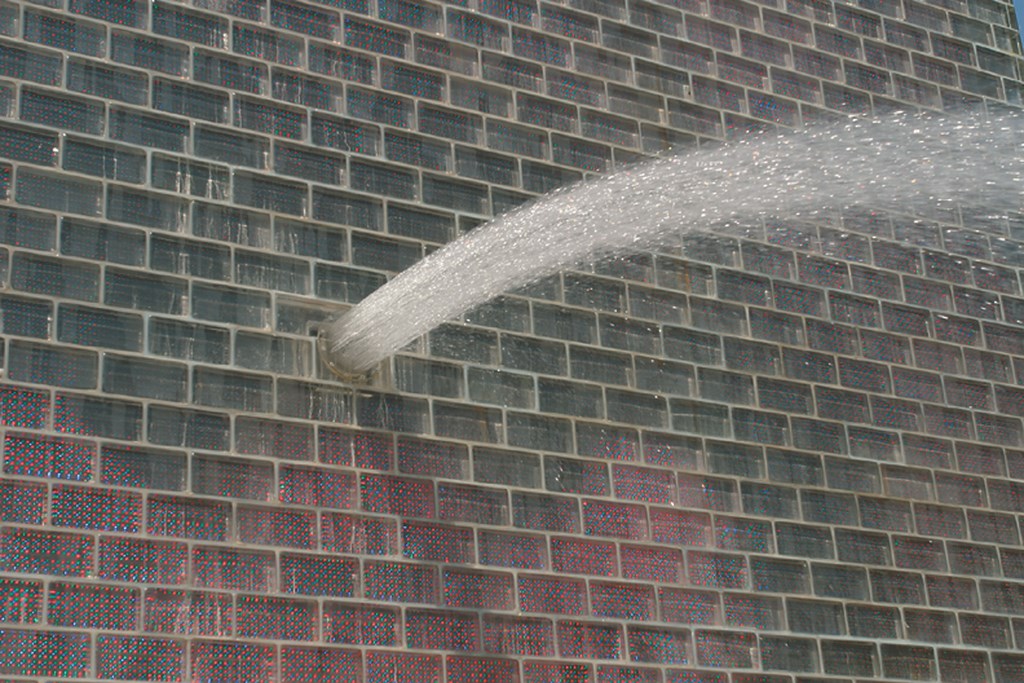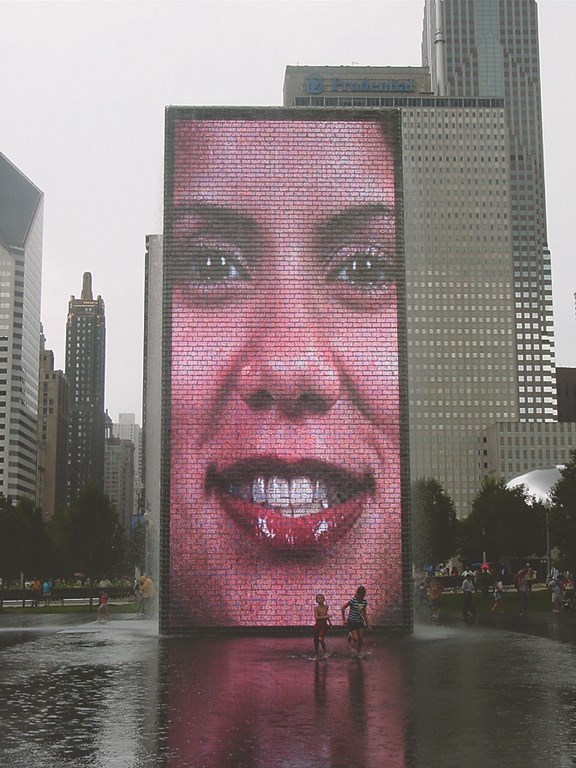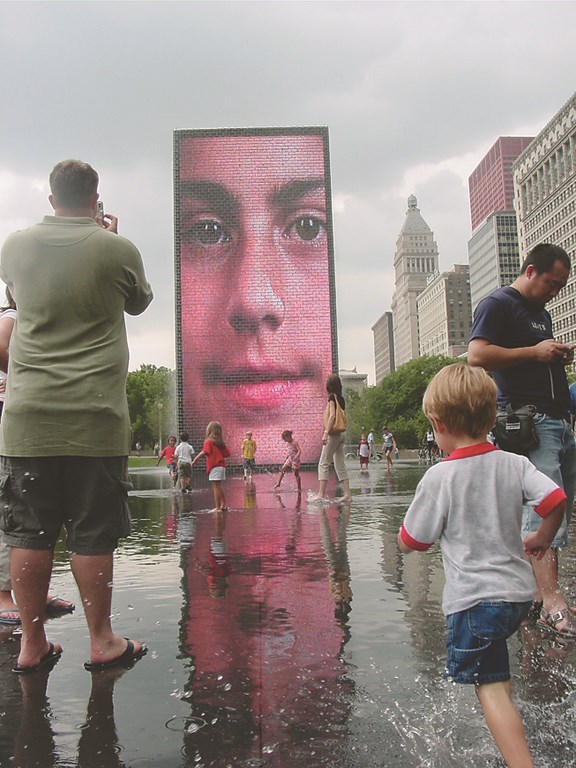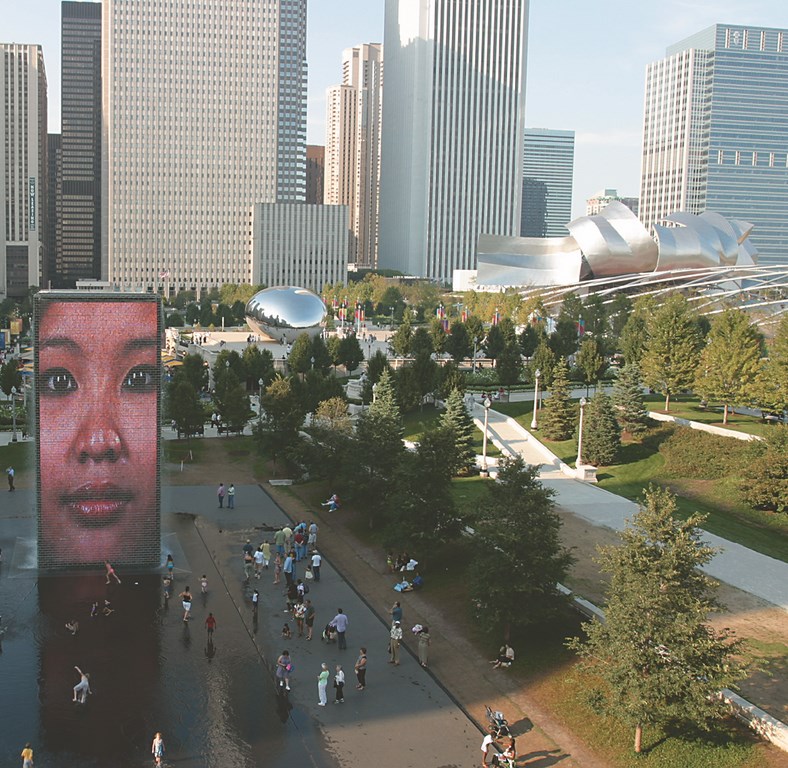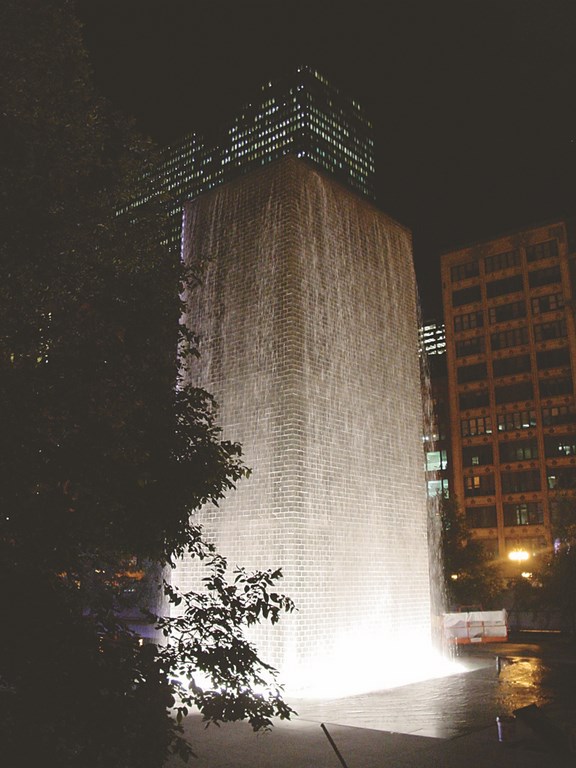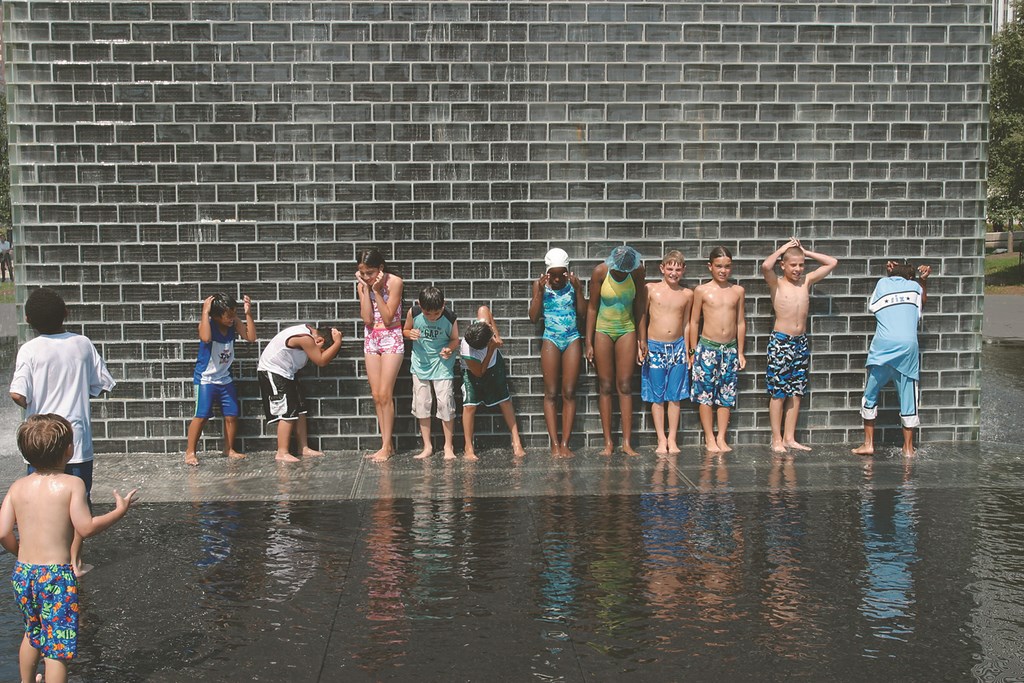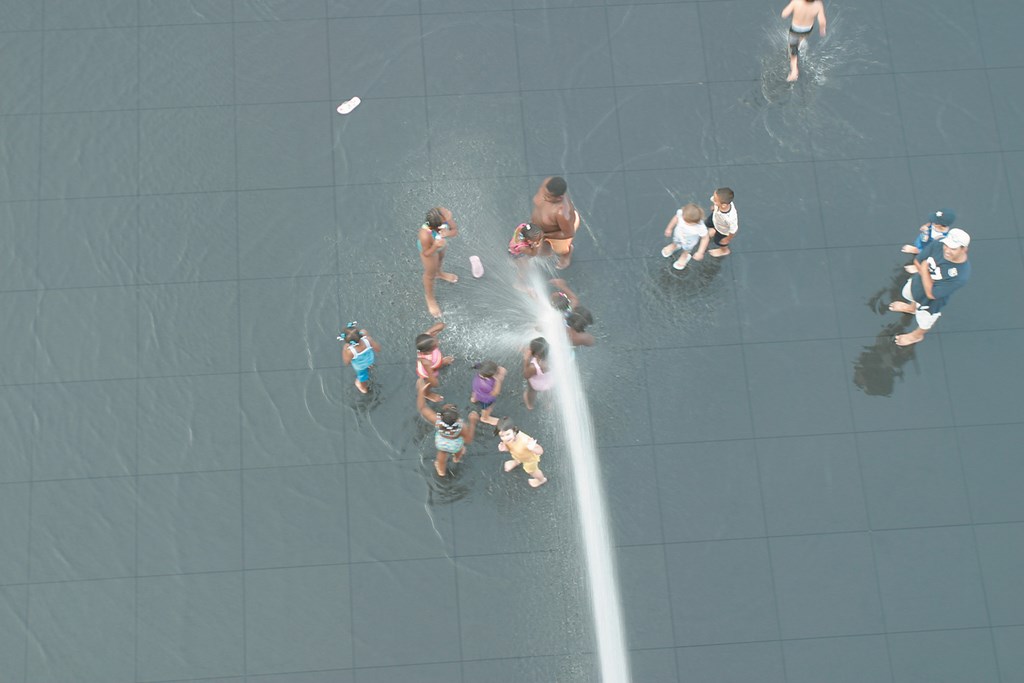A Crowning Achievement
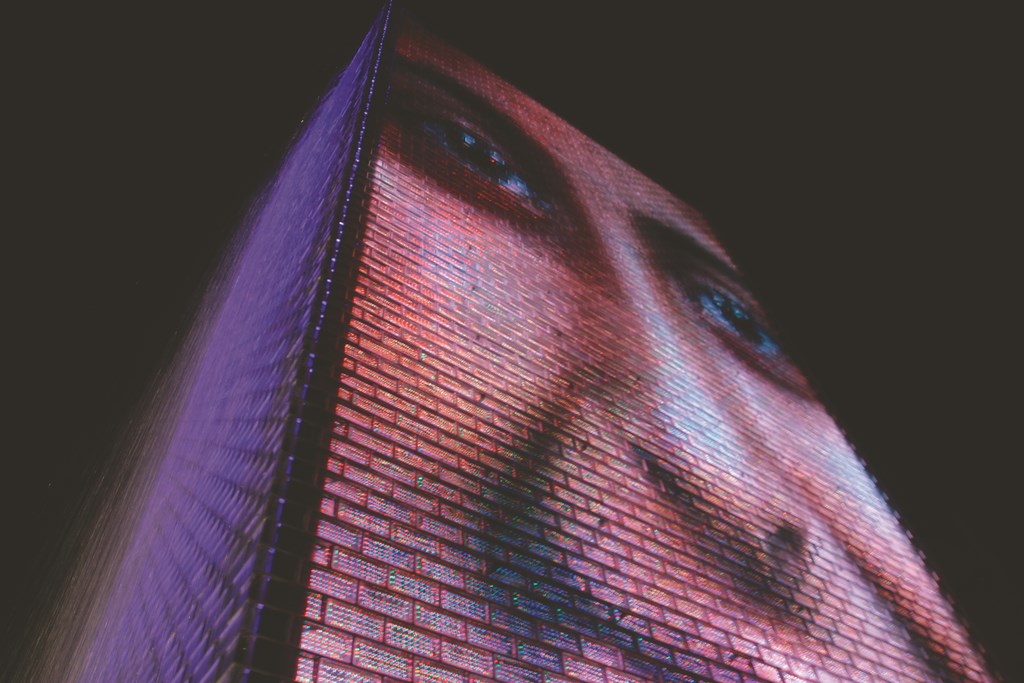
The Crown Fountain in Chicago’s Millennium Park is an ingenious fusion of artistic vision and high-tech water effects in which sculptor Juame Plensa’ s creative concepts were brought to life by an interdisciplinary team that included the waterfeature designers at Crystal Fountains. Here, Larry O’Hearn describes how the firm met the challenge and helped give Chicago’s residents a defining landmark in glass, light, water and bright faces.
In July last year, the city of Chicago unveiled its newest civic landmark: Millennium Park, a world-class artistic and architectural extravaganza in the heart of downtown. At a cost of more than $475 million and in a process that took more than six years to complete, the park transformed a lakefront space once marked by unsightly railroad tracks and ugly parking lots into a civic showcase.
The creation of the 24.5-acre park brought together an unprecedented collection of world-class artists, architects, urban planners, landscape architects and designers including Frank Gehry, Anish Kapoor and Kathryn Gustafson. Each contributed unique designs that make powerful statements about the ambition and energy that define Chicago.
One of the key features of Millennium Park is the Crown Fountain. Designed by Jaume Plensa, the Spanish-born sculptor known for installations that focus on human experiences that link past, present and future and for a philosophy that says art should not simply decorate an area but rather should transform and regenerate it, the Crown Fountain began with the notion that watershapes such as this one need to be gathering places.
URBAN INSPIRATION
In pursuing his design for the fountain, Plensa looked to history for guidance. Even a cursory view of art history tells us that in ancient times and in a variety of cultures, fountains often originated as wellheads around which people gathered for conversation, interaction and personal reflection. The Crown Fountain stands a purely modern version of that basic concept.
Plensa’s contemporary version of such a gathering place consists of a pair of 50-foot-tall glass-block towers that face each other across a broad, shallow skin of water. Projected onto the inner sides of the towers are the videotaped faces of more than 1,000 Chicago residents between 7 and 80 years of age.
Each of these faces is projected on the towers one at a time for 13-minute periods. Water falls down all four sides of the glass structures, providing an interactive element that brings children and adults close to the images as living counterparts of the artwork. During the final minute of each display period, the lips of the videotaped faces purse – and a spout of water appears to shoot from their mouths. 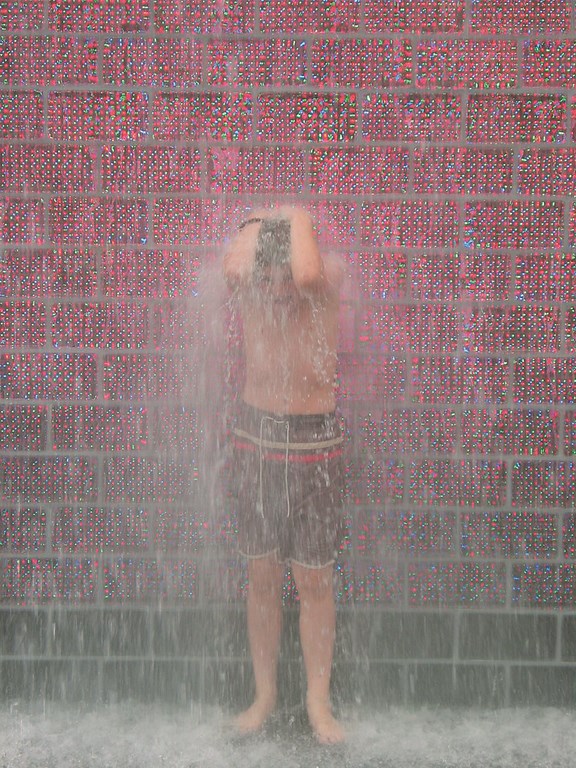
Our role at Crystal Fountains was to design the water effects and advise the project team on a variety of key issues based on our experience in creating interactive, computer-controlled water elements for public spaces. The result is one of the most advanced systems we’ve ever developed, and it’s been no small point of pride to see this work unfold in such a culturally significant setting.
The design of the Crown Fountain is all about the faces, which were selected and filmed by students of the Art Institute of Chicago to represent the racial and ethnic diversity of the city. Participants were asked to pose facing the camera for 12 minutes then, for the last minute, were told to blow a kiss. Current plans call for adding to the registry of faces at a rate of 500 to 1,000 in each five-year span.
Plensa sought to create a sort of dialogue between the images and the surrounding environment – a conversation perceived particularly well in the evening, when the character of the fountain transforms, the faces beam at their brightest, waterfalls and streams clearly emerge and the towers’ other surfaces glow with changing colors.
PHYSICAL BOUNDARIES
The glass-block towers are situated within a reflecting pool measuring 232 feet long by 48 feet wide. Surfaced entirely with African black granite pavers, the pool serves in basic functional terms to collect water flowing down the towers. To that end, the pavers sit over a reservoir that is actually about two-and-a-half feet deep. Atop the pavers, however, is a mere 1/8-inch skin of water.
The use of this thin sheet of water started with Plensa’s dream: “I don’t swim, so one of my dreams has been to walk on water. I wished to share my dream with the people here and say, ‘Please, come to my piece and walk on the water.’ “
On either side of the pool are benches framed by trees and other plantings to create a welcoming area for visitors who don’t want to get wet. By its nature, the fountain captivates children and adults alike: Children play in the fountain and wait breathlessly to run under the spouting mouths, while adults enjoy the “show” and the playful interactions of people, lights, sounds and water.
| The towers were built and clad in glass block while construction proceeded on the reflecting pool that stretches between them (top left and middle left). The key to the gargoyle effect is hidden inside: A special nozzle was fabricated in clear materials (middle right) so it disappears when the spout isn’t in operation and emits a hefty flow when periodically activated (right). We thoroughly tested the system to make certain the flow wouldn’t be so strong that small children would be bowled over by the force of the stream (bottom left). |
From the beginning, we knew that this design would embody the highest possible aspiration of water as an art form. The combination of the human face, interactive water and the magic of programmable animated features seemed to meld all the best that watershaping has to offer in public settings.
At the same time, we knew that making all of this come together in a seamless fashion would be no small task.
We were asked to join a project team of architects and engineers by developer U.S. Equities, with which we’ve collaborated on several past occasions. Our scope of work included the mechanical and electrical aspects of the towers along with a variety of other technical, aesthetic and practical issues – including our advice on interfacing the fountain systems with the architecture, public safety issues, risk assessment and the “personalities” that the feature would encompass.
All our work was shaped by the thought that this was a public feature that would enable people to interact with the water. As a result, our design work specifically included a formidable level of due diligence with respect to safety and accessibility.
THE GARGOYLE EFFECT
The spouting of water from the faces of the fountains, for example, presented certain risk factors. Based on our experience with other interactive fountains, we made several key recommendations about the volume and velocity of water allowed to fall on the small children who would stand in the stream.
We also made key aesthetic recommendations having to do with creation of a nozzle array for the spouting effect that would be completely invisible when not in use. The spout also had to be scaled in such a way that it suited the enormity of the images on the front of the fountain.
| The faces of the citizens of Chicago are projected on the towers’ inner faces, connecting the Crown Fountain to its community in a unique and intimate way. More than 1,000 people have lent their visages to the project so far, and the plan is to continue adding to this remarkableregistry of faces in years to come. |
In what became affectionately known as the “gargoyle effect,” this stream of water – actually the output of a number of jets – emerges from the towers to give the realistic impression that the water is spouting directly from the pursed lips of the faces. There’s a huge LED video screen visible behind the glass face, so we couldn’t us a large array of bronze nozzles.
Indeed, there was a premium on invisibility: The water appears to emerge from the mouths of the projected images; when the flow stops, the source of the water has to disappear. We’d created systems in the past with clear materials and invisible sources of water, but even with that background, we all knew that this system was different and would involve a great deal of design development to make it work visually.
Our solution involved development of an acrylic box that includes an array of nozzle openings on its face. This box in turn is mounted flush on the face of the glass-block structure, where it appears as part of the wall with no visual discontinuity. To ensure practical invisibility, water is fed into the nozzle array via clear acrylic tubing.
The solid acrylic nozzles contain internally drilled passages that disperse the narrow flow from the tubing into a spray pattern eight inches in diameter – thereby seriously diminishing the force with which the water reaches people standing in the stream.
The flow/pressure and starting dynamics of the spout effect are adjusted by coupling the pump motors to variable-frequency drives. The drives enable variable start-up and shut-down ramps for the effect – of great importance not only for minimizing the impact of the spray at floor level, but also for accommodating the wildly variable wind conditions that are so much a part of life in Chicago.
We started system development by setting arbitrary benchmarks for flow and velocity, then conducted extensive tests at Crystal Fountains’ test facilities with mock-ups to make sure we could follow through with the finished product. This testing included placing people of various sizes in the flow of water (including children and senior citizens) to be sure that a sudden flow of water from the fountain wouldn’t cause any kind of injury.
REFLECTIONS
As mentioned above, a major element of Plensa’s design was about giving visitors a sensation of walking on water in the large reflecting pool. The 1/8-inch depth was established as a standard – enough to give the desired impression without doing anything more than wetting the soles of visitors’ shoes.
This was simple in concept but posed a range of technical issues. For one thing, we had to figure out how to introduce the water without anyone seeing the source or disrupting the delicate skin of water. For another, we knew the shallow water would heat quickly under the summer sun. In addition, the overall water system had to accommodate the substantial flow down the tower walls and from the spouts.
Those considerations drove us to create a system that creates a convincing illusion of shallow depth while meeting all of the circulation, filtration and concealment issues.
All of this had to be accomplished atop a massive underground parking garage. (In fact, the entire park was built over a multi-level parking structure.) As a result, we didn’t have room for a huge reservoir; instead, we used the full footprint of the fountain area and suspended the granite pavers over a shallow (but collectively large) reservoir below.
| The artist who designed the Crown Fountain – Jaume Plensa – wanted those who walked onto the fountain’s reflecting surface to have a sensation of walking on water – a feat we achieved by covering the area with an eighth-inch skin of water that wells up between the gapped pavers from a reservoir below the deck. |
The pavers sit on prefabricated pedestals and the water is introduced via a manifold system from below, welling up in the narrow gaps between pavers. The amount of water and size of the gaps took considerable testing to ensure that the flow was invisible.
Surge capacity for the entire system was, of course, a major consideration in system design. A collection trough runs around the full perimeter of the reflecting pool to handle the flow. The towers also have independent reservoirs that serve as sources for their water effects and handle a portion of the surge capacity. This integrated system enabled us to run the skin of water right up to the bases of the towers.
Water level is controlled by a series of electro-mechanical float switches that activate at different set points. These set points are keyed to the operating parameters of the fountain and take into account such factors as pool draw-down and lighting protection. When a low water level is sensed, a solenoid valve allows fresh city water to enter the system reservoir. Once the valve is opened, the system monitors the water level by observing the on/off states of the float switches.
All of this works to create seamless reflections of the faces on the towers as well as the surrounding Chicago skyline. Indeed, the reflecting pool is an ever-changing canvas of moving light and images upon which visitors move and thereby become part of the artwork. In very special ways, this fusion of physical movement and visual interaction links the energy of the city to the people who inhabit Crown Fountain’s moving tapestry.
FALLING WATERS
The towers themselves are remarkable in their function and sophistication – all while retaining a profoundly simple aesthetic presence. Because they are made of glass, the internal structural, lighting, audio-visual and mechanical elements are all visible and were designed to become part of the artwork itself.
Stainless steel troughs run around all four sides of the towers’ tops. The front sides (with the LED panels) can operate independent of the troughs on the other three sides, with the rate of flow down the face and the sides determined entirely by the rate of flow that is fed up to the troughs.
| In addition to the signature spout detail, the fountain features waterfalls emitted from stainless steel troughs that run around the top perimeters of the two towers. Kids quickly pick up the timing for each effect and line the base of the monoliths when the water is about to flow. Some stay in for the duration, while others step away from the torrent. |
Based on the flows tested in demonstrations, the average spill rate out of the troughs is 20 gallons per minute for each linear foot of the trough. Depending upon wind speed, however, the pumps will provide flows ranging from 0 to 35 gpm per linear foot. An anemometer located at the top of each tower monitors the wind speed, reducing pump speed and flow as the wind picks up. When the winds spike, the flow stops altogether to prevent an undesirable misting effect.
We spent a lot of time with the design team storyboarding all of these water effects. The ultimate sequence includes the pursed lips and spouting water followed by a torrential downpour from the tops of the towers. Kids playing in the fountain have been quick to figure this out, and there’s a tremendous sense of anticipation as they wait both for the spout and then the downpour – after which the towers revert to a more sedate flow as the next face appears on the LED screen.
|
Giving Credit The Crown Fountain project would never have come to fruition without the full support of the donor family and the contributions of other members of the project team. Donor: Henry Crown & Company — L.O. |
The faces currently appear at random, and the programming we did allows for steady addition of new faces to the sequence. It certainly would have been easier to set things up for a limited range of faces in a certain order, but the project specifications called for continuous change and expansion as an expression of the artistic intent, so that’s the path we followed.
The operator’s control station (OCS) is the nerve system for the entire fountain complex. Its primary purpose is to monitor all aspects of waterfeature operation, perform routine system tests, send warnings and alarms and, if required, shut down the system for safety reasons. It is linked to audio-visual sequencing system in such a way that the “visual show” controls the spitting nozzles and waterwalls and processes input on wind speed and fountain status generated by the OCS. The interaction of these two control systems is designed for maximum flexibility.
The timing and flow rates for the tower troughs and the gargoyle pumps were established in coordination with Jaume Plensa and the full project team. We adjusted the control system accordingly, and it now monitors everything – vacuum switches, GFCIs, the automated water-treatment/filtration system and more – to maintain desired settings and specifications.
WATERWORKS
As is the case with any system designed for human contact, water treatment was important both for public safety and to ensure reliable operation.
Water is drawn from the reservoirs and pumped under pressure through sand filters. The filters are sized to control the buildup of waterborne particles and contaminants and operate 24 hours a day, seven days a week. Because water quality is a matter of public safety and not aesthetics, the OCS constantly monitors the filtration process and produces alarms if there are any failures in the filter units.
Electronic chemical controllers provide continuous monitoring and control of pH levels and chlorine concentration in the reservoir water. When water quality deviates from set parameters, pumps add chemicals as needed. This automatic water-conditioning equipment operates independent of the fountain control system – but reports to it.
| The spout really is the main event at Crown Fountain, with children lining up at just the right time to catch a cool blast of water from the pursed lips of the faces on the towers. It’s a tremendous attraction made possible by a marriage of control technology, hydraulic know-how, the determination of our staff and the formidable genius of the sculptor. |
This “watchdog” arrangement ensures that all water-treatment systems are performing as required, with the main control package providing the operating power for the chemical system. This means that the chemical system also shuts down when the main fountain control panel is turned off.
The parameters for water treatment are based on standards of the State of Florida for the treatment of swimming pool water. We’ve worked in a number of markets and have identified Florida’s standards as the most stringent in North America. It simply made sense to apply these high standards in this exceptionally high-use environment.
All of these integrated systems work in the service of what is one of the most intense and inventive aesthetic applications of the watershaping arts we’ve ever encountered. As it stands, Plensa’s remarkable creative vision is now enjoyed daily by thousands of visitors.
Unlike other programmable water effects in which much of the joy comes from the awe inspired by modern technology, this system is unique in the way it integrates the citizenry of Chicago within its overall program. There’s great fun in watching children and the young at heart frolic in the water, but there’s also a profound sense of civic identification that illustrates how a community consists of individuals and how their faces define its character.
For our part, this project is a crowning achievement in our portfolio of fountain technology – a source of pride and pleasure that will stay with us in the smiles it brings to our faces and to those of the people of Chicago.
Larry O’Hearn is a designer and project manager with the fountain/watershape specialists at Crystal Fountains of Toronto. He is a registered landscape architect and has been a member of the Canadian Society of Landscape Architects since 1985. He graduated with a degree in landscape architecture from Ryerson Polytechnic University in Toronto in 1982 and has been professionally involved in the design and construction of public and private spaces and watershapes for more than 20 years. O’Hearn joined Crystal Fountains seven years ago and currently leads the firm’s award-winning project team, which boasts some of the fountain industry’s leading design, engineering and product-development experts and works worldwide in creating uniquely enjoyable waterfeatures.











